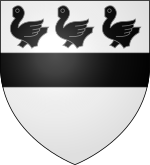Francis I of Beauharnais, seigneur de Miramion
| Beauharnais Leuchtenberg |
|
|---|---|
| Noble family | |

|
|
| Country | France, Brazil, Portugal, Germany, Russia |
| Estates |
Mariinsky Palace |
| Titles | |
| Style(s) | "Imperial Majesty" "Imperial Highness" "Serene Highness" |
| Founded | 14th century |
| Founder | Francis of Beauharnais |
| Final ruler | Hortense de Beauharnais |
| Current head | Nicolas de Leuchtenberg |
| Deposition | 1810 |
| Ethnicity | Breton (French) |
Beauharnais (or Leuchtenberg) is a French noble family. It is now headed by the Duke of Leuchtenberg, descendant in male line of Eugène de Beauharnais.
Originating in Brittany, the Beauharnais (or Beauharnois) became established in the fourteenth century in Orléans. When that city was besieged in 1429, Jehan Beauharnais played a role in its defence and by doing so witnessed to the process of Joan of Arc's rehabilitation. The Beauharnais provided the kingdom with soldiers and magistrates, and contracted alliances in several spheres, including that of the university of law in Orléans. In the 16th century, there were Beauharnais in Orléans as magistrates, merchants, canons and other professions.
From the end of the 16th century to the end of the 17th, the offices of president and of lieutenant général to the bailliage and siège présidial of Orléans were handed down hereditarily through the Beauharnais family. The most eminent of these magistrates was Francis IV de Beauharnais, sieur of la Grillère (at Vouzon, Loir-et-Cher), born in Orléans in 1630, and dying there in 1681.
At the end of the 17th century, the office of lieutenant général du bailliage d'Orléans was ceded to an allied branch, the Curaults. The most eminent of the Beauharnais thus turned to careers in the navy and the colonial administration in the Americas. Another François de Beauharnais (1665–1746) became intendant of New France (i.e. Canada), where a seigneurie was granted to him in 1707. His nephew, Francis V de Beauharnais, was made chef d'escadre des armées royales, then governor of Martinique.
The Beauharnais of Orléans were also great landholders thanks to their many seigneuries in the region. In the 15th century they were seigneurs of la Chaussée (or Miramion), fief of the parish of Saint-Jean-de-Braye, in the suburbs of Orléans. They also had interests at Sologne until the early 16th century, and Guillaume de Beauharnais held the estate of Villechauve, at Sennely. Some years later, the Beauharnais acquiring the neighbouring seigneurie of la Grillère, at Vouzon, with they held until the beginning of the 18th century (when it passed, by the marriage of a female Beauharnais, to the Choiseul-Gouffier family).
...
Wikipedia
